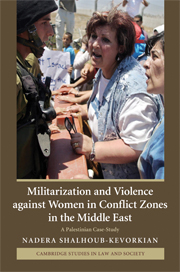 Militarization and Violence against Women in Conflict Zones in the Middle East
Militarization and Violence against Women in Conflict Zones in the Middle East Book contents
- Frontmatter
- Contents
- List of figures
- Acknowledgements
- 1 Introduction
- 2 Violent translations: women, war, and narrative in conflict zones
- 3 Veiled powers: conceptualizing woman and/as the ‘nation’
- 4 Women frontliners in conflict zones: a genealogy of weaponization
- 5 Speaking truth to power: voices of Palestinian women facing the Wall
- 6 Ruminations and final thoughts: women in-between
- References
- Index
3 - Veiled powers: conceptualizing woman and/as the ‘nation’
Published online by Cambridge University Press: 23 January 2010
- Frontmatter
- Contents
- List of figures
- Acknowledgements
- 1 Introduction
- 2 Violent translations: women, war, and narrative in conflict zones
- 3 Veiled powers: conceptualizing woman and/as the ‘nation’
- 4 Women frontliners in conflict zones: a genealogy of weaponization
- 5 Speaking truth to power: voices of Palestinian women facing the Wall
- 6 Ruminations and final thoughts: women in-between
- References
- Index
Summary
It is difficult to start a revolution, more difficult to sustain it. But it's later, when we've won, that the real difficulties will begin.
(Giles Pontecorvo, ‘The Battle of Algiers’, in Jacqueline Siapno 2001)On her way to school, fourteen-year-old Tamam stopped to speak to me. Pointing to her battered backpack, she asked me what I thought she carried on her back. I was somewhat bewildered by her question, so she answered me herself: ‘Do you think I carry only books in my pack? I carry the burdens of the Palestinian people.’ I relate this brief and multilayered exchange with a young girl because, it seems to me, it epitomizes where we must begin any discussion of ‘women and nation’ in Palestine. It is also critical to remember that in this instance the ‘nation’ is, as of yet, a concept only; it does not materially exist as such. Additionally, what Tamam's comment reveals is that in the case of Palestine we need to reprogramme our thinking on what it means to ‘build a nation’ and of what such a ‘nation’ might consist.
The history of the region is perhaps an all too familiar and almost tedious case study of marking, as on an imaginary map, a ‘nation’ and then an attempt to articulate a corresponding ‘nationhood’ through actual geographic borders and boundaries.
- Type
- Chapter
- Information
- Militarization and Violence against Women in Conflict Zones in the Middle EastA Palestinian Case-Study, pp. 77 - 111Publisher: Cambridge University PressPrint publication year: 2009
